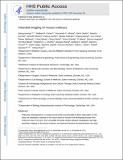Intravital imaging of mouse embryos
Author(s)
Huang, Qiang; Cohen, Malkiel A.; Alsina, Fernando C.; Devlin, Garth; Garrett, Aliesha; McKey, Jennifer; Havlik, Patrick; Rakhilin, Nikolai; Wang, Ergang; Xiang, Kun; Mathews, Parker; Wang, Lihua; Bock, Cheryl; Ruthig, Victor; Wang, Yi; Negrete, Marcos; Wong, Chi Wut; Murthy, Preetish K. L.; Zhang, Shupei; Daniel, Andrea R.; Kirsch, David G.; Kang, Yubin; Capel, Blanche; Asokan, Aravind; Silver, Debra L.; Jaenisch, Rudolf; Shen, Xiling; ... Show more Show less
DownloadAccepted version (1.478Mb)
Open Access Policy
Open Access Policy
Creative Commons Attribution-Noncommercial-Share Alike
Terms of use
Metadata
Show full item recordAbstract
© 2020 The Authors. Embryonic development is a complex process that is unamenable to direct observation. In this study, we implanted a window to the mouse uterus to visualize the developing embryo from embryonic day 9.5 to birth. This removable intravital window allowed manipulation and high-resolution imaging. In live mouse embryos, we observed transient neurotransmission and early vascularization of neural crest cell (NCC)-derived perivascular cells in the brain, autophagy in the retina, viral gene delivery, and chemical diffusion through the placenta. We combined the imaging window with in utero electroporation to label and track cell division and movement within embryos and observed that clusters of mouse NCC-derived cells expanded in interspecies chimeras, whereas adjacent human donor NCC-derived cells shrank. This technique can be combined with various tissue manipulation and microscopy methods to study the processes of development at unprecedented spatiotemporal resolution.
Date issued
2020-04Department
Whitehead Institute for Biomedical Research; Massachusetts Institute of Technology. Department of BiologyJournal
Science
Publisher
American Association for the Advancement of Science (AAAS)
ISSN
0036-8075
1095-9203